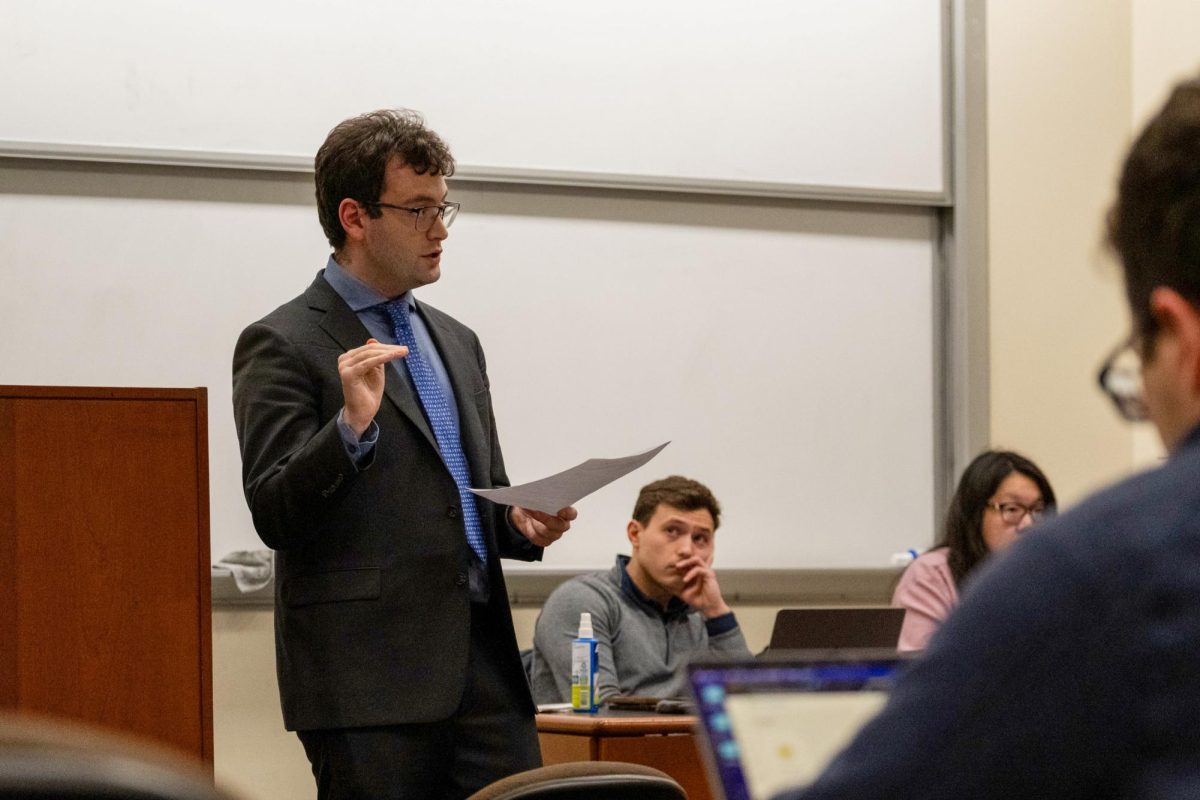Updated: May 11, 2021 at 6:12 p.m.
A professor from the School of Engineering and Applied Science discovered that a stomach virus can survive and continue to spread despite common sanitation practice.
The study, published last month with the National Institutes of Health, found that the norovirus – a highly contagious gastrointestinal virus – is resistant to disinfectant practices like ultraviolet light treatments and detergent solutions. Danmeng Shuai, an associate professor of civil engineering and the lead researcher of the study, said his results indicate that common decontamination procedures like using ultraviolet light to kill viruses in water-supply plants and cleaning surfaces with common household detergents may be ineffective.
The norovirus is considered the leading cause of foodborne illnesses, leading to anywhere from 19 to 21 million cases of vomiting and diarrhea illnesses in the United States each year, according to the Centers for Disease Control and Prevention. Shuai said the norovirus has more “protection” against outside stressors, like disinfectants and ultraviolet light, because it travels in vesicles that conceal it more so than other viruses that travel freely.
He said vesicles are like sacs outside of the cell that hide clusters of the norovirus inside them and make the virus more resistant to forms of disinfection like ultraviolet light. Ultraviolet light can be used to kill viruses in drinking water – a sanitation method that may really be ineffective following Shuai’s discovery of the protective vesicles.
“We need to revisit our current disinfection practices, because all the current guidelines are designed based on the disinfection of the free viruses,” Shuai said. “People didn’t know about the viral vesicles before so they never considered redesigning the current disinfection guidelines.”
Shuai said Mengyang Zhang, a doctoral student in SEAS, conducted experiments on norovirus particles by comparing how long single free and clustered virus particles survived against stressors like detergent. Shuai said Zhang and the other researchers used ultraviolet lights, detergents and freeze and thaw cycles to test the strength of the norovirus at a lab at the NIH.
Researchers shined ultraviolet light at varying strengths for different amounts of time on groups of virus clusters like the norovirus and free viruses to see which was more resistant, according to the study. Shuai said the virus clusters were more resistant to ultraviolet light, suggesting that ultraviolet disinfection may not be an effective method of killing the norovirus, which is commonly found in water supply plants that hold drinking water.
Shuai said they found that viral vesicles concealing the norovirus are “really, really robust,” and that the norovirus will survive even under extreme temperature changes since the vesicles did not decay in the freezing temperatures.
The researchers also found that the virus clusters in vesicles were 2.16 times more resistant to disinfection than the free viruses, according to the study.
He said this is just a “pioneer study,” and researchers still need to test other compounds like chlorine and ozone, which may be able to break down the virus.
“We need more study to understand that, but it brings up a possibility that these viral vesicles can be escaped from the current disinfection and sanitation processes and survive,” Shuai said.
Nihal Altan-Bonnet, a researcher at the NIH and the co-leader of the study, said when multiple variants of the norovirus travel together in a vesicle, one variant of the virus may not be able to make a specific enzyme, but the other variants can make it for the benefit of the entire vesicle.
Altan-Bonnet said the norovirus enters the cells in our bodies, replicates and then enters vesicles in the cell. She said the cell then sheds these vesicles which go and infect other cells.
“Inside each one of those vesicles is not one, but many norovirus particles, five, six norovirus follicles, maybe more,” Altan-Bonnet said. “And then those vesicles leave the cell, the cell remains behind intact, alive, keeping on shedding these vesicles. Then it’s these vesicles that go and infect another cell.”
Mengyang Zhang, a doctoral student at SEAS, said she was able to join the research team as a member of the GW/NIH Graduate Partnership Program.
Zhang, who joined the program in October 2019, said the work has helped her explore her interests in both biology and environmental engineering. She said environmental engineers often do not conduct these projects on virology because recognizing virus problems is not typically studied in their field.
“After I joined this program, I got very systematic training of virology at NIH,” Zhang said. “And also, I can utilize my environmental engineering background to do interdisciplinary research, so I can combine both of my backgrounds.”
Experts in biology and food sciences said the norovirus spreads in densely populated settings and has a protein code, making it more resistant to disinfectants than other viruses that are enveloped in a cell membrane, like the coronavirus.
Lee-Ann Jaykus, an assistant professor of food sciences at North Carolina State University, said the Environmental Protection Agency allows companies to label their disinfection products as anti-norovirus if they work against norovirus surrogates, viruses that are supposed to replicate human norovirus behavior, which can be misleading.
“So many of the products that are out there that services say ‘we have anti-norovirus activity’, well, they have anti-norovirus activity against the surrogates,” she said. “But if you were to test them on human norovirus, that likely would not translate.”
Christiane Wobus, an associate professor of microbiology at the University of Michigan, said alcohol-based hand sanitizers do not inactivate the norovirus. She said hand sanitizers are meant to dry out a virus cell’s membrane and break it open, but the norovirus’s protein code outside its membrane blocks this function.
“In case of SARS-CoV-2, you inactivate the virus by breaking the membrane because now the virus can get into the cell,” she said. “In the case of noroviruses, you break the membrane and free the particles, which then can still infect the host.”
Sejal Govindarao contributed reporting.
This post has been updated to correct the following:
The Hatchet incorrectly spelled Mengyang Zhang last name. It is now corrected. We regret this error.








